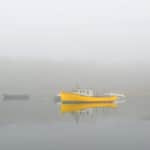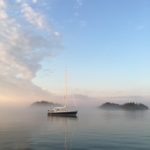
Fog is Fun!
Someone out there has been giving Maine fog a bad name. They say it’s treacherous, dangerous, difficult to navigate in and to be avoided at all costs.
Perhaps with some tips and perspective adjustment, we can change all that negative energy that fog seems to attract.
My wife, Jane, and I have been cruising and racing in Maine fog for over 40 years. We started with a compass, depth sounder, and log. Two observations I can give with certainty. First, over those 40 years, we have gone aground a total of three times, and all three times were on sparkling clear days. Never have we gone aground in fog. The reason for this is that navigating in fog requires paying close attention to your course, position, and surroundings. Sailing in clear weather invites nonchalance and the many distractions not present in the fog.
The second observation is that fog seems to us to be much less frequent in recent years. We clearly recall in our early cruising being out for a week and a half and never having a clear day, with the view of our surroundings centered on a rare glimpse of a passing buoy or island and, of course, the ever-present radar images. In recent years we can generally count on one hand the number of times we even bothered to switch on the radar. One year recently, we never turned it on. 2023, however, has been a fog over-achiever with abundant fog and almost daily radar use.

Here are suggestions for a more enjoyable and safer fog experience:
- Get the best electronics and learn how to use them in clear weather. Over the years, we’ve progressed from compass, log, and depth sounder, to Loran C, to monochrome radar, to GPS lat/lon, to chartplotters, to color radar with MARPA, to radar overlay, and to the absolute best advancement ever, AIS.
- Many recreational vessels now have AIS as do all ships and ferries in Maine. If you have a constant bearing with another vessel or a ship, you will likely have 20 to 30 minutes warning (when sailing offshore) of the impending situation and plenty of time to contact the other vessel and negotiate how the crossing is going to occur.
- In clear weather, pretend it’s foggy, and learn how to differentiate a buoy, boat or small island on your radar display. It's also a good idea to become comfortable with the range settings on your radar to see what's most useful in different situations.
- Have your radio on channel 16 to listen for other vessels announcing their course, position, and destination. This is required of commercial vessels. I would note that sometimes everyone seems to feel they need to issue securité calls, which often becomes too much information.
- You should also be prepared to make the appropriate sound signals, but again if everyone is doing it all the time, the situation becomes muddled, so be selective.
- One prolonged blast at intervals of not more than two minutes is the signal used by power-driven vessels when underway.
- One prolonged blast plus two short blasts at intervals of not more than two minutes is the signal used by vessels under sail.
- Pay close attention to your course and immediate line of sight. It is easy to become disoriented in fog and lose your sense of direction without something on the horizon to fix on, given the need to also be on the lookout for objects not showing up on radar.
- It’s best to have at least two pairs of eyeballs – one as the lookout and the second for steering and monitoring instruments
- Thick fog is not the best time to try a new and complex approach to a harbor. Head for bold shores and familiar passages if you can.
- Thick fog is also not a good time to be transiting narrow, rock and lobster pot strewn waters, defining many parts of coastal Maine. It’s best to wait for the fog to lift, allowing 50 to 100 yards of visibility.
- SLOW DOWN if there is significant traffic in the vicinity or visibility is less than 50 yards
- Don’t make your waypoint right on a buoy for two reasons. We have come close to colliding with a buoy when the autopilot is precisely following our GPS route, and suddenly, we have to alter course. A more important reason is that everyone else is probably headed for that same buoy, so it can get crowded in a hurry.
- Don’t forget that Coast Guard regulations require running lights to be on when navigating in limited visibility.
- Have sunglasses ready. When the fog begins to burn off, you can be in zero visibility and intense glare at the same time.
- It’s always best if both you and your partner/spouse/shipmate are communicating and collaborating in solving the navigational puzzle and that the helmsperson always knows whether the safe water is to the left or right should a sudden course adjustment be needed.
- While lobster boats generally don’t show on AIS, they almost always show up on a good radar set, and most of them have radar and can see you. More than anything, they are generally loud (unmuffled exhaust), so you should be able to hear them.
- Lobster gear can present a significant challenge in fog, in that you don’t see the buoy and or toggle until the last minute. Whenever possible, avoid areas with heavy lobster gear placements when the tide is running perpendicular to your course, as the gear will be stretched across your route of travel, making it much more likely to cause a problem.
- Every boat has different characteristics when it comes to getting through lobster gear. On our fin keel, spade rudder boat we have almost no problems if we are making good speed of seven to eight knots. If we are drifting along at three or four knots, it’s a different story. If we’re motoring and I miss seeing a buoy or toggle, my best option is to hit the throttle to change the trajectory of the line as its passes beneath us, but all boats have different characteristics. We always carry a shorty wetsuit, mask and flippers. Our running gear has a shaft razor, and we also carry a hook knife on a long pole. (See separate blog/article on “Tips for Avoiding Lobster Gear”)
- Most importantly, do get out and practice in the fog occasionally because sooner or later, you will start in unlimited visibility and SHA-ZAM! fog will appear. You’ll need to have acquired the confidence in your navigation and equipment to make it safely and stress-free to your destination.
- If you tire of your fog run, and the land-based forecast is sunny, head up one of the dozens of bays or rivers, and most likely, you’ll be compensated with sunshine and warm temperatures.
- If you awaken to fog, your patience may be rewarded by a delayed departure—as the day heats up, frequently the fog will subside or at least retreat offshore.
But how can fog possibly be fun?
- Sailing in thick fog, for all of its sensory deprivation, can also give the sensation of flying. It’s truly surreal.
- Treat every fog run as a refresher course for your navigational skillset.
- Revel in the speed with which fog can dissipate. We all treasure a sunrise at sea, but that can take over half an hour from false dawn to the sun’s appearance. When the fog burns off, it can cause your surroundings to change from impenetrable gloom to bright sunshine in an instant. Of course, the onset of fog can change just as quickly.
- While having a schedule is the bane of safe and low-stress cruising, having confidence in your fog navigation skills gives you much greater flexibility and control over your itinerary.
- Completing a fog passage is an immensely satisfying accomplishment. Take a bow!


